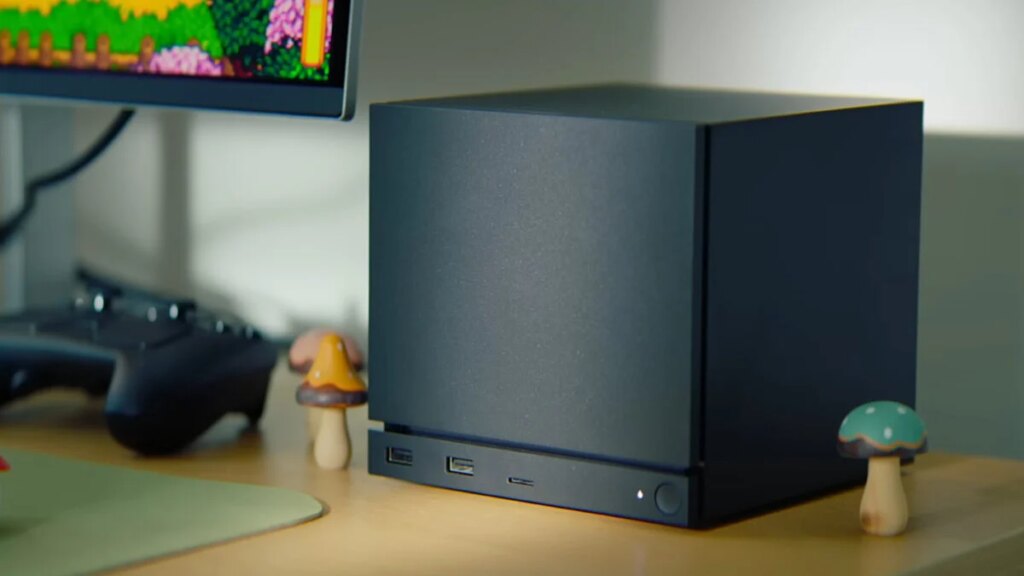The next generation of consoles won’t be cheap by today’s standards, and neither will Valve’s hotly anticipated Steam Machine. The little, cube-shaped console is a bundle of PC parts inside a box, and Valve reps have consistently said it may demand PC-like prices. Considering the cost of those individual components, what that means for the price could be drastically different just a few months from now.
Valve has not given any official word regarding price or release date for its PC/console hybrid device. In an email with Gizmodo, Valve hinted it could arrive early next year. The roughly 6 x 6-inch box with a small LED light bar houses a “semi-custom” AMD chip with the option for changing out RAM or SSD storage. The console uses Valve’s own SteamOS with its clean interface to let you access games or settings. It’s otherwise using component PC parts, which makes sense considering Valve has long been a brand focused on the PC market. However, Valve has consistently implied this may demand PC-level pricing.
In a video interview with the YouTube channel Skill Up, Valve software engineer Pierre-Loup Griffais implied that the Steam Machine would not be “subsidized,” as in Valve does not intend to help absorb some of the cost to make it more competitive with today’s console market.
“It’s more in line with what you might expect from the current PC market,” said Griffais. “Obviously, our goal is for it to be a good deal at that level of performance.”
Griffais added that there’s very little on the PC market that exists currently that offers an easy living room experience, one that lets you boot up and navigate the console with just a controller.
That line about price is consistent with what Valve told The Verge, that it will essentially be equivalent to a PC of similar specs. So what does that mean? If the Steam Machine is based on PC parts without any subsidies, that means it probably won’t cost $500 or $550, the current price of Valve’s Steam Deck or a Sony PlayStation 5 (after price hikes).
A Steam Machine houses a GPU on par with the mobile version of the AMD Radeon RX 7600, though with a higher thermal design power (TDP), which can potentially boost graphics performance. In trying to estimate how much the Steam Machine might cost, IGN cited devices like the MSI Thin B13VF, a near-$800 gaming laptop with a Core i5-13420H CPU, 16GB of RAM, 512GB SSD, and a discrete Nvidia GeForce RTX 4060 GPU.
Increasing RAM prices could add to the cost
Valve has implied that most gamers would still appreciate a Steam Deck, as it will still be better than ‘70%’ of most gamers’ PCs. © Valve
But there are so many other factors to consider, especially since a laptop’s cost includes the display and keyboard. Though if Valve truly doesn’t intend to subsidize the Steam Machine’s cost, that would require making room for the skyrocketing price of memory across the board. The Steam Machine is notoriously using 8GB of VRAM on its GPU—which may not be exactly what you want for playing the most intensive games at 4K—but it has 16GB of DDR5 RAM and options for 512GB or 1TB of SSD storage.
RAM prices have doubled or tripled over just two months, mainly due to demand from AI data centers. Unless Valve has stockpiled a boatload of RAM to stuff into Steam Machines, the rising cost of RAM sticks could further add to the console’s pricing.
Griffais added that the Steam Machine is quiet and powerful despite its size. Plus, it comes with integrated Bluetooth and wireless with four antennas for four separate controllers. When you consider the size of the console—it’s practically half the size of an Xbox Series X—the Steam Machine is pretty powerful, though a $750 PS5 Pro still has the upper hand. Still, Valve told Adam Savage’s Tested that the “GabeCube” (a portmanteau of Valve CEO Gabe Newell and the Nintendo GameCube) will “outperform 70% of current gaming PCs.”
Next-gen consoles won’t be cheap, either
The PlayStation 5 Pro costs $750 now after price hikes. The regular PS5 without a disc drive now costs $500. © Kyle Barr / Gizmodo
How the Steam Machine performs next to PCs matters far less than how it compares to today’s consoles, even though they’re getting more expensive every year. There are multiple signs that the next-generation Xbox could be significantly more powerful than today’s 5-year-old Xbox Series X, and that means it could demand a price around $1,000. Sure, that’s cheap for a gaming PC, but it isn’t what console gamers expect. The rumored PS6 may end up costing less than its counterparts, but if memory prices keep on their trend, Sony’s next-gen console could also be costly. Valve may have 2026 all to itself for new hardware, but eventually it will have new competition.
The Steam Machine may simply be a blueprint for other original equipment manufacturers (OEMs) to make their own SteamOS-based consoles at varying price points. We’ve seen this happen with the Steam Deck. However, while tons of OEMs such as Lenovo have put out handheld PCs like the Legion Go S, none of them have really competed on pricing. All of them have swum upstream with more powerful hardware that costs more, so we wouldn’t be surprised if OEMs can’t (or won’t) push the price down from what Valve prices the Steam Machine at.
If we really want a console that can push gamers to jump for Steam (or Windows on Xbox, for that matter), it needs to be something console gamers can afford.

